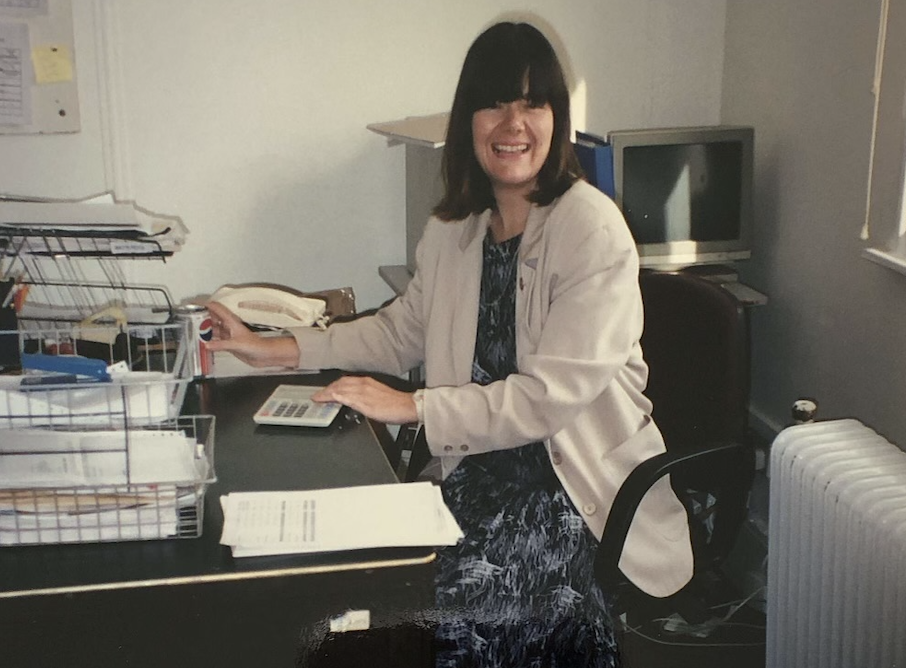
[swmsc_image src=”https://thinkcs.org/wp-content/uploads/2019/12/Mich-300×300.jpg” align=”left” link=”#” lightbox=”true” lightbox_type=”image” border_radius=”10px” alt=”” title=””]
On 15th February I will have been a fundraiser for 30 years – or perhaps more accurately, I should say I have been a professional fundraiser for 30 years as, when I think about it, I’ve actually been a fundraiser for almost all my life. My mum and dad were very active in what was then called the Parents’ Association during my primary and secondary school years and I have fond memories of manning stalls at jumble sales and Christmas bazaars, as well as distributing and collecting raffle tickets to households where fellow pupils lived – no GDPR or data rules then! Not to mention various sponsored activities when I was a Brownie and Guide: spelling, singing (being silent; never anything too physical – though silence was always a challenge for me!) and plenty of putting pennies in Lent saving boxes from Sunday School!
I guess many people fundraise alongside their parents during their childhood and teenage years. When I look back, I think the point at which fundraising became an ‘owned passion’, rather than a partly imposed activity, was when I cut a coupon out of a newspaper in my first year at university to send a donation to, what was at that time, Imperial Cancer Research Fund in memory of a favourite junior school teacher who had died. Rag collections and raising funds for our college common room were a feature of my time in York and perhaps to an outsider, a career in charity might have seen an obvious choice when I stepped out into the world of work… but not quite yet. YMCA turned down my application to join them as a community fundraiser in 1987 – that gives me a little smile now!
Being a volunteer fundraiser took a much more serious turn after my dad had a heart attack in 1990. What followed was my first real experience of fundraising as a profession, as my family engaged with our local BHF volunteer committee. I always felt sorry for the community fundraiser when she ran the gauntlet of an often grumbling set of committee members and was secretly envious of her having a job with a car, little knowing how many miles and late nights she endured behind the wheel. By now I was working in the fast moving fashion industry, in Topshop’s buying office, and while I owe so much of my commercial acumen and love of numbers to those years, I was becoming increasingly disillusioned with an industry that seemed to care little about the wellbeing and development of their staff, and only focused on lining the pockets of unseen shareholders. And then I applied for a role in the retail and trading team at the British Red Cross – and the rest, as they say, is history.
As you might know, in my role at THINK I spend a lot of time thinking about and talking about trends that are impacting fundraising practice – in the immediate, medium and long term. So, as I mark this professional anniversary, I’ve been looking back as well as forwards, and thinking about how much – and how little – fundraising and the wider sector have changed over the last three decades. I’ve picked out seven themes that immediately sprang to mind as I started writing this piece. There are undoubtedly more.
Reliance on legacy income
The sector has always been and remains heavily reliant on gifts pledged in wills and, with the baby boomer generation in its twilight years, this shows no sign of abating anytime soon. This topic has vexed and concerned executive teams, fundraisers and trustees across the years. But really, should it? Given the still low incidence of a pledge to charity in wills, shouldn’t the focus of attention for legacies be on investment in marketing and stewardship to sustain legacy income levels, rather than on moving investment elsewhere to diversify? After all, death is the only certainty we all have in life. So maybe the time has come to stop fretting and keep investing in legacy growth. Of course, income diversity is desirable and helps to buffer the lumpy nature of legacy receipts and investing in other fundraising streams can ultimately feed the legacy pipeline too. So shouldn’t the driver be equally to maintain/grow high levels of legacy income and grow streams around it? This may mean the overall % contribution legacy makes does reduce, but it will still be a major contributor.
Given the still low incidence of a pledge to charity in wills, shouldn’t the focus of attention for legacies be on investment in marketing and stewardship to sustain legacy income levels, rather than on moving investment elsewhere to diversify?
Technology has changed every aspect of how we fundraise
By far the greatest game-changer in the last 30 years has been the advance and acceleration of technological solutions to many of the everyday challenges we face in delivering fundraising. Imagine being a prospect researcher before the internet existed or trying to galvanise supporters during the pandemic if postal mail was the only communication channel available. Let alone actually managing to work during a national lockdown. When I joined the British Red Cross, one of the first ever charity DRTV campaigns for the conflict in the former Yugoslavia had been launched. Fast forward to 2023 and the changing way we consume programming, plus the proliferation of channels, has mainstreamed this acquisition technique – another example of how technology has impacted fundraising technique.
Technology allows us to move faster, more effectively and to drive inefficiencies out of our working practices; to reach almost anyone, almost anywhere. However, in reality, the fundraising sector has only scratched the surface of what is possible in my opinion. The sector remains largely inhibited by protracted approval processes, risk adverse attitudes and – above all – woefully insufficient investment in technology. In the vast majority of cases, we remain on the back foot in terms of data collection, analysis and insight. In 1993, Tesco Clubcard didn’t exist – now the loyalty scheme boasts over 17 million members and is regarded as a best-in-class retail scheme, using vast amounts of data collection, manipulation and analysis to drive customer relationships. In stark contrast, many charities remain bogged down in trying to make the best of years of underinvestment in databases and data. While the data revolution has theoretically put a multitude of insights at our fingertips, we remain largely unable to use and sweat data assets.
Add to this the increasingly widespread application of AI and the advent of the metaverse, and the case for investment becomes imperative. It really is now or never for many fundraising operations.
Income generation beyond fundraising – still a fractious relationship
[swmsc_image src=”https://thinkcs.org/wp-content/uploads/2023/02/Screenshot-2023-02-13-at-14.00.18-300×245.png” align=”right” right=”#” lightbox=”true” lightbox_type=”image” border_radius=”10px” alt=”” title=””]
I started my fundraising career in the retail and trading team at the British Red Cross and, while we were part of a supporter engagement directorate, it wasn’t always the happiest of relationships with our fundraising team siblings – or indeed with some of the organisational function teams. The finance system couldn’t give us the information we needed in a format or timescale that made sense. Our lower ROI meant investment in new activities was grudgingly accepted by our fellow fundraisers, and there was a sense that no one really got us! Fast forward to recent years, where the THINK team has worked on a number of projects that look beyond long-standing fundraising streams, and the same tensions and issues remain. And in charities where fundraising is a smaller part of the total income pie, the misunderstandings and frustrations proliferate even further.
So perhaps we need to accept that this is just how it is, embrace the creative tension created, and use it to surface better ideas and outcomes, rather than fighting it? Because, without a doubt, we need the audiences and income that lie beyond fundraising, as well as our core fundraising activity, to enable our causes to survive and thrive.
Navigating legislation and regulation
The charity sector is no different to any other sector in having to continually adapt to and navigate changing legislation and regulation – think financial services for example. Back in 1993, the 1992 Charites Act was casting a shadow over what charities did and how they had operated. Since then we have seen successively faster waves of legislation, not to mention the shift in fundraising regulation caused by the events of 2015, plus the advent of GDPR. We have approached all of these with trepidation and concern as they have changed the way we can and should deliver our fundraising and wider charitable aims and activities. We rely on sector bodies to advocate and challenge as bills pass through the process of becoming law. And like all sectors, we adapt and continue within a new framework. What’s key is keeping on the front foot with what’s coming down the tracks and what the impact is likely to be – “Forewarned, forearmed” as the saying goes. My advice is to engage but not worry when inevitably the next wave comes towards us.
Recession – rarely the beginning of the end
By the end of 2023, I will have lived through three recessions during my time in the fundraising profession. That’s roughly one a decade, although the impending one comes very hot on the heels of the last one (2020 Q1 and Q2). Looking back over the available statistics, fundraised income fell by less than GDP but took longer to recover to pre-recession levels. In 2020 we saw high value supporters – trusts, philanthropists and corporates – step up to help charities meet the challenge of recession in a way never seen before. The sector has survived but not without casualties, job losses and freezes. As we head into what is expected to be a five-quarter contraction, we should change the narrative and be looking for cost efficiencies as much as cost savings, and try to slow down rather than stop completely new initiatives, aiming to keep existing supporters and donors close and giving what they can. We need to remain bold but sensitive in our asking and accept that, for peer-to-peer fundraising, the ask for support from personal networks becomes harder, so lower our expectations of average gifts in that area, while using data and giving patterns to understand who can be asked more frequently and for more.
Fundraising – a profession of choice
[swmsc_image src=”https://thinkcs.org/wp-content/uploads/2023/02/MC-BRC-1-300×191.jpeg” align=”left” link=”#” lightbox=”true” lightbox_type=”image” border_radius=”10px” alt=”” title=””]
When I joined the British Red Cross, almost everybody had worked in a different sector and had fallen into fundraising rather than setting out from education to join the profession. Fast forward 30 years and, while the fundraising sector is still a second career stop for many, I do see increasing numbers of individuals who have chosen to pursue a career in fundraising from the get-go. There are now a number of graduate and post graduate qualifications in fundraising, as well as the clear qualifications path provided by the Chartered Institute of Fundraising. This gladdens my heart as it is one of the best and most rewarding professions in my opinion. I’m excited to see what comes next as the Institute matures into its chartered status and moves on from the choppy waters it has sailed in over recent years. But for me, the real turning point will be when my great nieces and nephews are able to talk to me about their fundraising lessons at school and are excited to choose fundraising as a GCSE or A level (or whatever they are called by then). That is the moment that fundraising will truly become a profession of choice.
Equality, diversity and inclusion – moving the dial painfully slowly
Sadly for me, this is the area in which I see the least progress in the last 30 years. When I look at the composition of fundraising teams across the sector, I see a similar set of faces to those who greeted me in 1993. For a sector that seeks to make the world a better and a more equal place for all, we have failed to properly reflect that in our workforces and working practices. EDI is now a priority for many organisations, and it is everyone’s responsibility to understand and embed EDI thinking in all that we do.
While so much has changed, so much remains the same. Fundamentally, whatever tools, techniques and technologies we have at our disposal, successful fundraising boils down to this: tell a compelling story about your work to people who have a connection to your cause; motivate them to give money, voice and time; and then work hard to make them a lifetime friend. And your work will be done!
Michelle Chambers, THINK’s Managing Director
February 2023
_________________________________________________________________________________________
If you would like to discuss our THINKing further, please contact our central office on info@thinkcs.org.
You can also find us on LinkedIn at THINK Consulting Solutions and on twitter @ThinkCS, where we share useful industry insights.
Related posts
Did our 2025 predictions come true? Reflections from the THINK team
We revisit our January 2025 fundraising predictions and explore what actually happened: what…


What the 2025 community fundraising mystery shop reveals about the supporter experience
This year’s THINK mystery shop shows that when charities invest in meaningful engagement,…


How do charity services shape local fundraising?
In his first month as THINK’s new Director of Data, Steven White reflects…

Sign up to our email newsletter
We call it ‘Something to THINK About’ – a regular dose of sector insight, ideas and updates, straight to your inbox.
